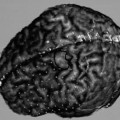
Image-Guided Neurosurgery Combining Mechanical Arm and Optical Digitizer
The decade of the 1990s was a transition time for technological innovation in neurosurgery. Computer-assisted surgery was introduced into the operating room, and by the end of the decade it had become a mainstream technology adopted by neurosurgeons worldwide. The term frameless stereotaxy was casually applied to the use of image-guided navigational systems in surgical procedures. Initially these systems were used as navigational instruments to follow the progress of tumor resection in open craniotomies. Recently, there has been widespread promotion by the spine implant companies to market these systems for use in the placement of pedicle screws, another form of open navigation. Today these systems continue to be used as open navigational tools in the great majority of cases. There has been minimal activity regarding the use of these systems for true stereotactic procedures; thus the term frameless stereotaxy is a misnomer.
This chapter is devoted to an image-guided system capable of advanced stereotactic applications in imageguided surgery. The Mayfield ACCISS system (Ohio Medical Instrument Company, Cincinnati, OH) was developed with innovative hardware and software components to successfully carry out and verify the precision of frameless stereotactic image-guided procedures.
 History and Development of Digitizers for Image-Guided Surgery
History and Development of Digitizers for Image-Guided Surgery
The concept of surgical navigation was introduced by linking computer systems and digitizing instruments. These early computers had the capacity to process and render a three-dimensional model of the magnetic resonance imaging (MRI) or computed tomographic (CT) image of the patient’s cranium. The digitizing instruments use multiple technologies to locate a point in three-dimensional physical space and to process that information in the computer.1 These digitizers include sonic emitting probes, mechanical arms, infrared optical camera systems to track surgical probes embedded with light-emitting diodes (LEDs), and probes moving through electromagnetic fields.2–10 Using one of these forms of digitizer, the surgeon matches or registers identifiable points on the patient to the same points on the patient’s MRI or CT image reconstructed by the workstation. When this registration is successfully completed, one can navigate around and within the patient’s anatomy using the digitizing probe and see the virtual representation of the probe move about with respect to the pertinent image in the workstation.
 Development of Digitizing Technology
Development of Digitizing Technology
The decade of the 1990s saw an evolution of this digitizing technology and the continual development of faster, more powerful, and less expensive computers. It became apparent that each type of digitizing instrument possesses certain drawbacks that make its use as a surgical instrument somewhat difficult at times. Sonic digitizers, because of ambient noise interference in the operating room, never achieved practical utility.2 Mechanical arms enjoyed a brief period of popularity in the early part of the decade, but the systems available at that time fell into disuse because of their cumbersome size and weight, which made them difficult to use in surgery.4–9 They were also criticized because they had to be attached to the table or headrest and this tethering was undesirable. In spite of the opinion that mechanical arm digitizers may be the most robust and accurate of all digitizers, they were displaced by optical tracking systems. Electromagnetic systems have not gained widespread acceptance because of the apparent inaccuracies caused by contamination of the electromagnetic field by all other necessary instrumentation in the surgical field. Recent developments in this technology suggest that electromagnetic tracking may overcome these problems and has the potential to displace optical tracking in popularity because it eliminates the major drawbacks of optical tracking.11 Specifically, with electromagnetic tracking there is no camera, and the need to maintain open optical pathways is eliminated.
Optical tracking systems are currently the most popular form of digitizer accepted and promoted in the marketplace in spite of significant drawbacks to their use. It is difficult to maintain an optical path free of interference in a usually crowded environment around the operating table. Placement of the camera in a strategic position over the field so that it can “see” the encoders on the digitizing instrument at all times presents a constant challenge. Turning or angling the probe out of the camera’s range disrupts the tracking process, and the image and the probe’s position on the computer screen are disrupted until the probe is returned to the position so that it can be “seen” again and the image restored. Other interference is encountered by drapes and IV poles and the movement of the hands and arms of assistants passing instruments. Introducing the microscope into the operating field makes the unrestricted use of optical tracking very challenging.
Many improvements have been introduced into optical tracking technology. The original probes required a wire to electrically power the LEDs. Recently, wireless probes have been introduced that contain a small nickelcadmium battery powering the wireless LED-containing probes. Alternatively, passive optical tracking technology was introduced. Multiple large reflecting spheres can be attached to any pointing instrument, and an infrared light source placed on the camera allows the camera to “see” the reflection of the light from the spheres. This passive technology eliminates the power cord and enables the tracking of many different instruments, which may be especially attractive for spinal applications. Nonetheless, in spite of these improvements interference in the optical pathways in a restricted and crowded operating environment presents a continuous annoyance.
Other problems associated with optical tracking include the need to maintain the integrity and working order of all of the LEDs and to ensure that the reflective spheres are clear of blood and debris, which can diminish their ability to provide an accurate reflection. Troubleshooting an optical system that is not functioning properly when needed, usually after the operation has commenced, can be time-consuming and frustrating and may occasionally require discontinuation of the procedure if an alternative digitizing technique is not available.
 Common Applications of Image-Guided Surgical Navigation Systems
Common Applications of Image-Guided Surgical Navigation Systems
Image-guided surgery is most widely utilized in the brain and spine for tracking the probe’s position with respect to the anatomy involved. These applications are fairly straightforward. Commonly image-guided surgery is used for locating a small craniotomy flap strategically placed over a small tumor. It is used to track the progress during open resection of intra-axial neoplasms such as gliomas and extra-axial lesions such as meningiomas and acoustic neuromas.12,13 In the spine the most common application is for the placement of lumbar pedicle screws. More difficult and challenging applications for open navigational procedures include the use of imageguided surgery for the resection of pituitary adenomas and the placement of thoracic pedicle screws and transarticular screws at the C1–C2 level.
 The Concept of Frameless Stereotaxis
The Concept of Frameless Stereotaxis
The term frameless stereotaxis was used early to refer to this new technology. More accurately described, these devices are computer-assisted, image-guided surgical navigation systems. The initial belief was that this technology would replace and make obsolete frame-based stereotaxis. That has not happened and these systems are still used largely as navigational devices for open surgical procedures. Enthusiasm for the term frameless stereotaxis may have reflected a hope to eliminate the current method of frame-based stereotaxis. In frame-based stereotaxis a bulky mechanical device surrounding the cranial vault is affixed to the patient by screwing four pins under high pressure while the patient is awake and aware of what is being done. This technology requires the patient to wear the device until the procedure is completed. More recently, some surgeons have attempted to perform true point-in-space stereotactic procedures by using image-guided systems and adapting existing hardware to facilitate this more complex level of application of image-guided surgery and, thus, eliminating the stereotactic frame.14–
Stay updated, free articles. Join our Telegram channel

Full access? Get Clinical Tree




